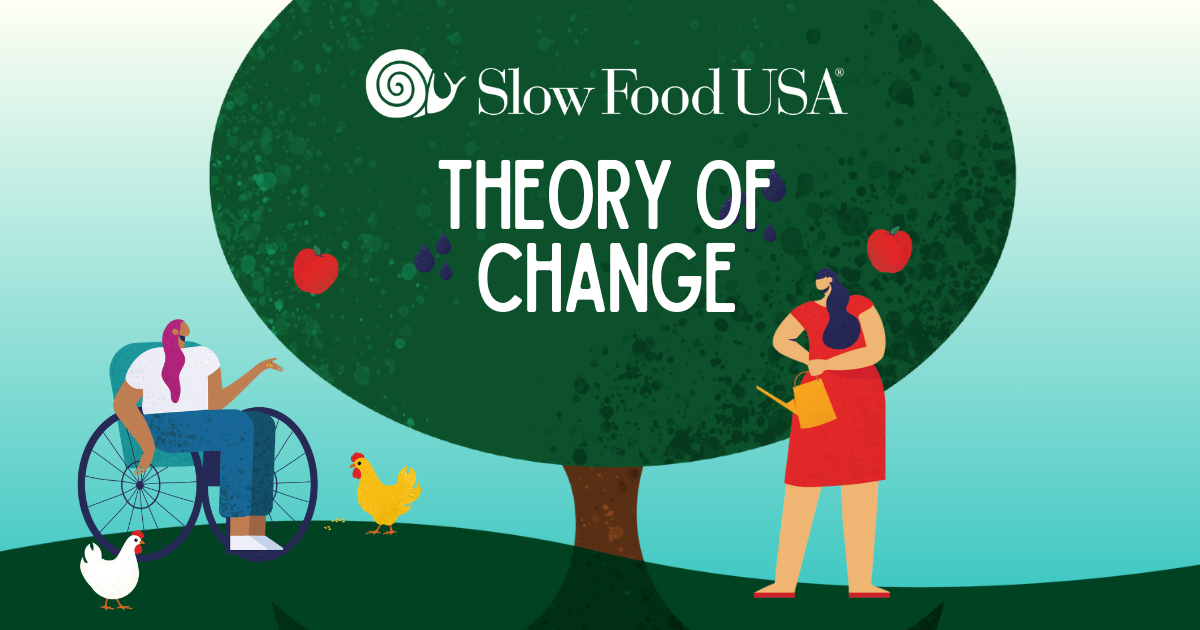By Anna Mulè, Executive Director of Slow Food USA

We have just emerged from a 20-month process of creating a Theory of Change and are super proud to present this compelling document to you!
Why should you care about a theory of change?
Slow Food is a lot of things to a lot of people. For some people, it’s all about the ethos of the sweet Slow life, where we savor long conversations around a table. For others, it’s about teaching kids in a school garden how green beans creep up a pole and taste so fantastic. Others prefer to call their federal and local policymakers to demand good, clean and fair food for all. We have fish harvesters and chefs, students and elders in our network.
The thread that weaves all these beautiful souls together — the spark that draws us to Slow Food and makes us lifers — is what we articulate in the Slow Food USA Theory of Change. Broadly speaking, a theory of change is an organization’s defining and unique approach to solving the complex problem it’s here to solve. This is the common language of who we are, what we do and why we do it.
A Collaborative Process
The reason it took 20 months to write a 16-page booklet is because the voices and beliefs of over 100 leaders and members are embedded in those pages. Here’s what we did:
-
- Mapped the network
Who are the key partners in the network and how do they relate to each other? This map is our answer to that. - Engaged the network
We used a variety of channels to listen to network leaders:- 2021 Annual Report: 83 submissions by chapters and community action teams to this required report.
- Focus Groups: Four sessions with an average of eight active leaders in each session from across the US.
- Interviews: Three one-on-one interviews with Equity, Inclusion and Justice Strategist Dan Mueller and other Slow Food USA leaders who identify as Black, Indigenous and People of Color.
- Network Survey: 20 respondents to a general, written survey sent to the network.
- Reviewed the internal and external landscape
We spent time looking at similar organizations, reviewing existing strategy documents (especially from Slow Food International, our global convening body), and examining historical strategic plans and reports.
- Mapped the network
- Analyzed the data
Staff reviewed all the data, pulled out key phrases, and grouped phrases by theme. We then developed a narrative that tied datasets together in a cohesive story about Slow Food. At every stage, we solicited feedback from staff, leaders, Slow Food International directors and the SFUSA board of directors, making edits after each round, to gradually hone our document into a final that incorporated many voices into one beautiful narrative.
- Implementation
Now that we have a final document, we are creating a management plan so that budgets, staff work plans, and programs are all lined up with the Theory of Change. We are asking chapters and communities within the network to do the same — to integrate this document into your local mission and programming, so everything ladders up to the big picture purpose.
Melding Joy with Justice
In the United States, good food and Slow Food are sometimes paired with elite food and expensive food. We want to make it clear that our vision is about joy and justice melded together — and may the two never ever separate. If you lay out a delicious spread with the finest wine and farm-to-table cuisine that only wealthy white folks can enjoy, that is not Slow Food. If you throw rocks in protest and never rest your body or delight in flavor, that is not Slow Food either. This is a delicious revolution. I hope you take some time to reflect on the introductory context that lays out why food is political, and on the values for how we do this work.
Slow Food is a global movement, and we are happy to align with other national associations doing unique and powerful work that reflect Slow Food International’s pillars and call to action. We also recognize that antiracism work needs to be intentionally embedded into our work across the world, in our systems and processes, as we outlined in the Slow Food in Americas Anti-Racist Motion that we submitted to the International Congress in 2022. We are eager to shift the political impact of the international movement towards racial justice, and to urge action to denounce, expose, mitigate and eliminate structural racism in our societies.
What do I do with this document?
We are asking chapters and communities to share the visual representation of the Slow Food Theory of Change within your chapter, supported by the explanatory narrative that walks you through each segment. What do you notice? What resonates most deeply with you? Are there areas of tension we can discuss?
Please consider how you can integrate this guide into your local mission and programming. We will be rolling a toolkit for strategic planning at the local level, and we will be crafting future annual report questions around the Theory of Change. We will need to see alignment with the Theory of Change to consider chapters and communities in good standing. This should be easy, since the document came out of the amazing work of chapters and leaders! If you have questions or concerns, we welcome a conversation.
Without further ado, here is the Slow Food USA Theory of Change.


Personally, I believe that I can bring assistance to Slow Food USA by participating in Weavers and Storytellers roles.